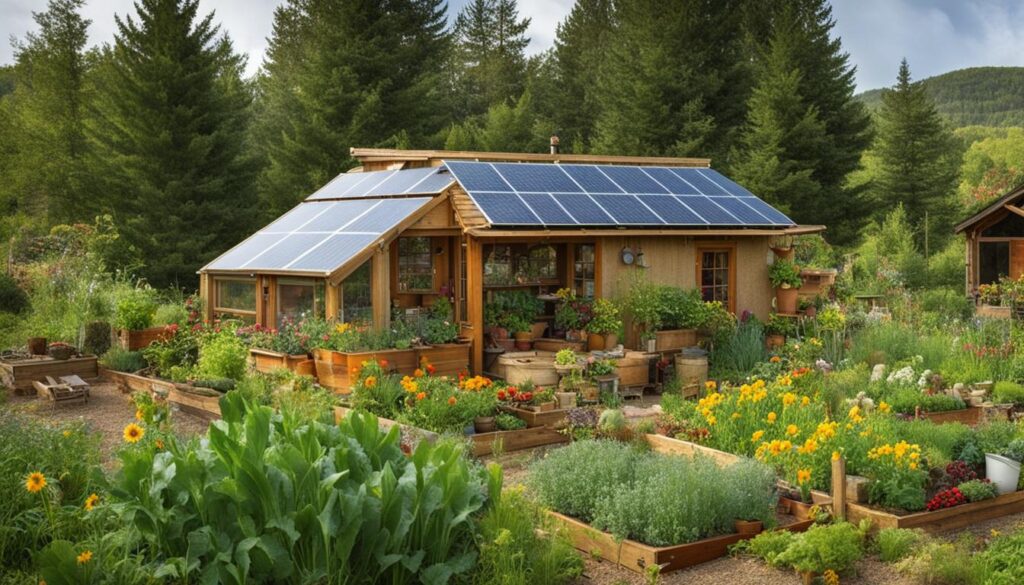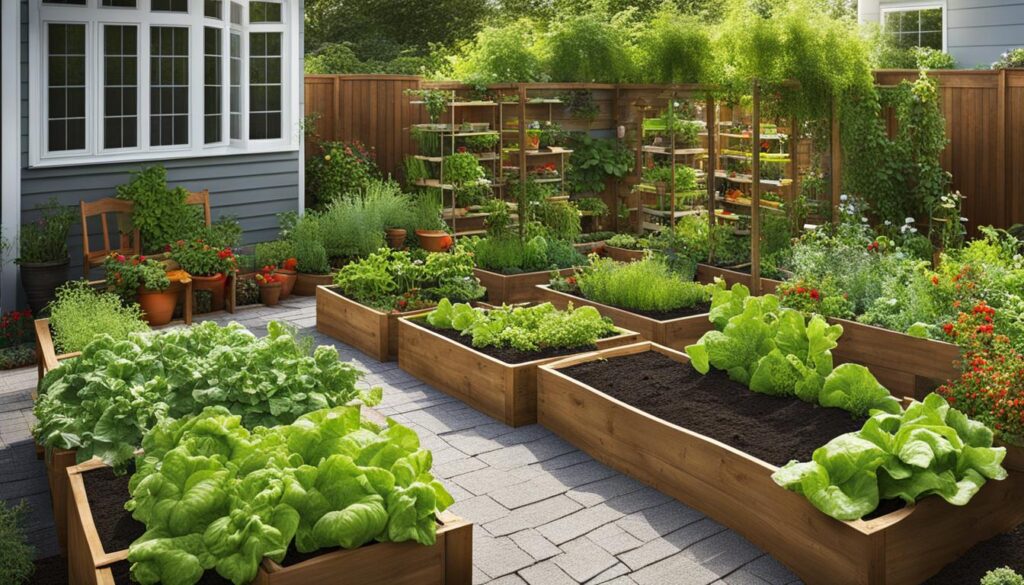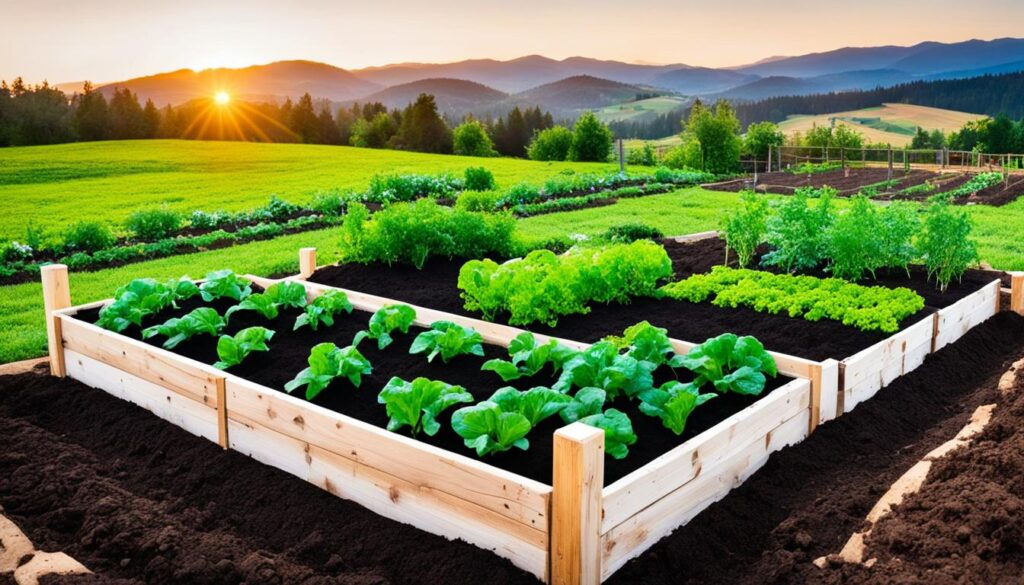
Homesteading offers endless opportunities to improve your home, garden, and lifestyle while embracing self-reliance and sustainability. Whether you’re looking to enhance your energy efficiency, harvest rainwater, or create a resilient and productive food system, there are plenty of DIY projects that can help you achieve a self-sufficient lifestyle on your homestead. In this article, I will explore a variety of DIY homestead projects that are cost-effective, utilize natural and reclaimed materials, and promote eco-conscious living.
Key Takeaways:
- DIY homestead projects help you embrace self-reliance, sustainable living, and simple living.
- Building projects on your homestead promote self-sufficiency and a more eco-friendly lifestyle.
- Homesteading allows you to utilize natural and reclaimed materials, reducing waste and promoting sustainability.
- Off-grid living can be achieved through DIY energy and water projects, reducing reliance on external sources.
- Creating a resilient and productive food system on your homestead contributes to food self-sufficiency and reduces reliance on store-bought produce.
DIY Energy Projects for Your Homestead
Energy is a crucial element on a homestead, regardless of whether you are on or off the grid. Incorporating renewable energy sources is a great way to become more self-sufficient and reduce reliance on fossil fuels.
One of the most popular DIY energy projects for homesteaders is building a solar hot water heater. It utilizes the power of the sun to provide your household with hot water, reducing your reliance on traditional water heating methods. By harnessing the renewable energy from the sun, you can save money on energy bills and contribute to a more sustainable future.
Another innovative project to consider is creating a solar dehydrator. This simple and cost-effective solution allows you to preserve your garden harvest or foraged fruits and vegetables by harnessing the sun’s energy to remove the moisture. It’s a sustainable alternative to traditional electric dehydrators and a great way to extend the shelf life of your produce.
If you’re interested in sustainable cooking methods, you can also explore making a solar oven. A solar oven uses the sun’s heat to cook food, reducing the need for conventional ovens or stovetops. It’s an eco-friendly way to prepare meals and can be particularly useful during power outages or off-grid living situations.
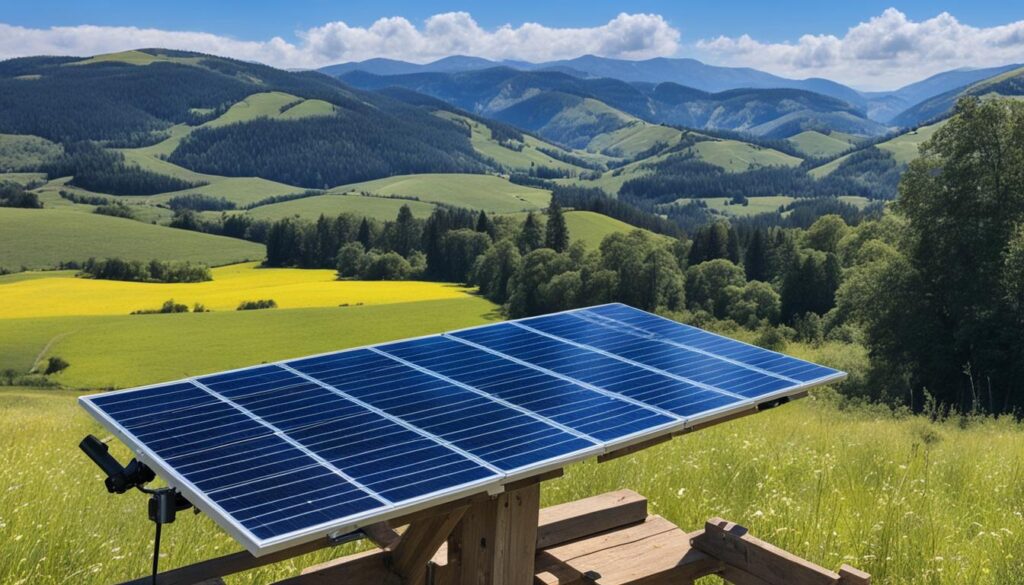
By implementing these DIY energy projects, you can take a step toward a more sustainable and resilient homestead. Harnessing the abundant energy from the sun not only reduces your reliance on non-renewable resources but also saves you money in the long run. Whether you’re looking to heat water, preserve food, or cook using solar power, these projects offer practical solutions for embracing renewable energy and energy efficiency on your homestead.
DIY Water Projects for Your Homestead
Water is a vital resource that plays a crucial role on your homestead. To enhance your self-sufficiency and preparedness for any changes in your water supply, implementing DIY water projects is essential. These projects not only provide you with a reliable water source but also contribute to water conservation and effective water management on your homestead.
Rainwater Harvesting
One of the most popular DIY water projects for homesteaders is setting up a rainwater harvesting system. This method allows you to collect and store rainwater for various purposes, such as watering your garden, livestock, or even for household use. By utilizing rainwater, you can reduce your dependence on external water sources and conserve water efficiently.
Earthworks for Rainwater Management
Directing rainwater with earthworks is another effective DIY water project. By strategically shaping the landscape, you can direct rainwater to specific areas of your property, such as gardens or storage tanks. This approach maximizes rainwater absorption, reduces erosion, and helps in recharging groundwater reserves. With proper planning and implementation, you can effectively manage rainwater and optimize its use on your homestead.
Water Management Planning
Proper water management is essential for ensuring a reliable water supply on your homestead. Creating a water management plan involves assessing your water needs, monitoring usage, and implementing measures to conserve water effectively. By tracking your water consumption and adopting water-saving practices, you can minimize wastage and maximize the efficiency of water usage in all aspects of your homestead.
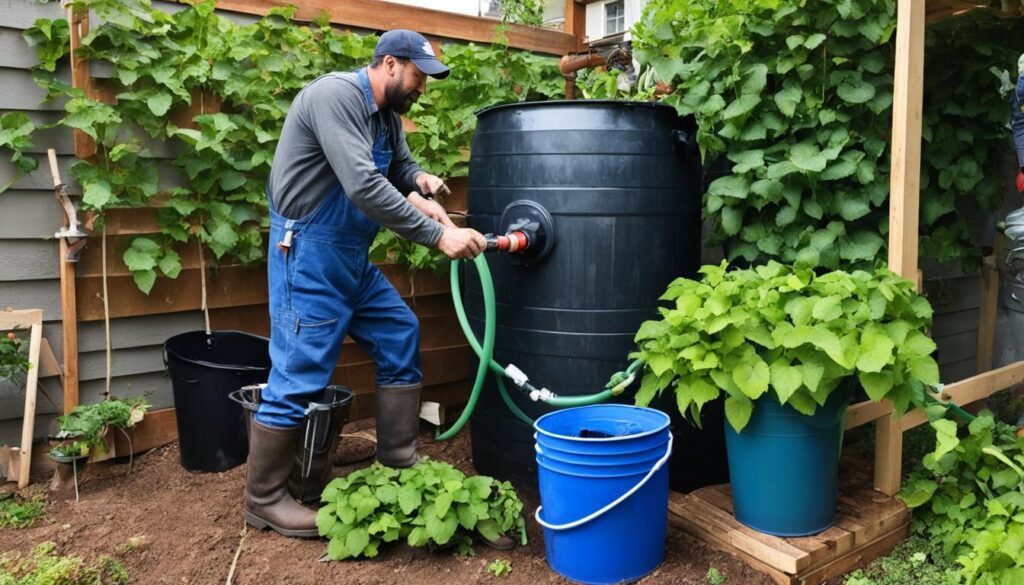
With these DIY water projects, you can become more self-sufficient in water supply and better equipped to face any water-related challenges. By harnessing the power of rainwater, implementing earthworks, and adopting effective water management practices, you can ensure a sustainable and resilient water system for your homestead.
DIY Food Projects for Your Homestead
Building a resilient and productive food system is a key aspect of homesteading. Engaging in DIY food projects not only promotes self-sufficiency but also reduces reliance on store-bought produce, allowing you to enjoy the fruits of your labor. By exploring various projects, you can cultivate a sustainable and bountiful food source right in your backyard.
Composting: Turning Waste into Nutrient-Rich Soil
One of the fundamental practices in sustainable gardening is composting. Setting up a composting system allows you to recycle organic waste from your kitchen and garden, reducing landfill waste while creating nutrient-rich soil. Composting not only enriches your soil but also improves its structure, water-holding capacity, and overall fertility. To get started with composting, follow these steps:
- Choose a composting method: You can opt for a traditional compost bin, a worm composting system, or a compost pile.
- Collect organic waste: Gather kitchen scraps, such as fruit and vegetable peels, coffee grounds, and eggshells, along with yard waste like leaves, grass clippings, and plant trimmings.
- Create the compost pile: Layer the organic materials with a mixture of “greens” (nitrogen-rich materials like fresh grass clippings) and “browns” (carbon-rich materials like dry leaves and shredded paper). Remember to turn the pile regularly to promote decomposition.
- Monitor and maintain: Keep the compost pile moist but not waterlogged, and aerate it occasionally to prevent odor and facilitate decomposition. Within a few months, you’ll have rich, dark compost ready to nourish your garden.
Sustainable Gardening: Sowing Seeds and Creating a Food Forest
Growing your own food is a satisfying and sustainable way to achieve food self-sufficiency. From sowing seeds to establishing a food forest or perennial polyculture, there are various DIY projects you can undertake for a productive and abundant garden.
- Sowing seeds: Start your plants from seeds to have a wide variety of crops while saving money. Invest in quality seeds, create a simple greenhouse or seedling tray, provide them with adequate light and moisture, and watch your garden flourish.
- Food forest and perennial polyculture: Embrace the principles of permaculture by designing a food forest or perennial polyculture system. Plant a diverse range of trees, shrubs, and perennials that complement and support each other, providing a sustainable and low-maintenance food source for years to come.
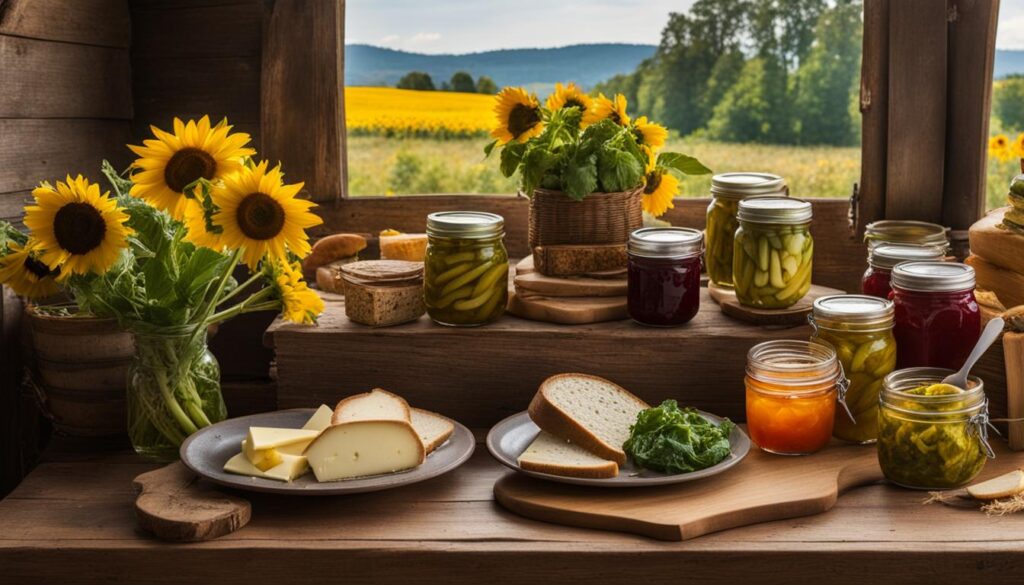
Food Preservation: Maximizing Your Harvest
Achieving food self-sufficiency also involves preserving your harvest for long-term enjoyment. From canning to drying, there are several DIY food preservation techniques you can explore:
Preserve the flavors of the harvest with DIY food preservation techniques.
- Canning: Stock up your pantry with homemade jams, pickles, and canned fruits and vegetables. With basic canning equipment and recipes, you can safely preserve your harvest and enjoy the taste of summer all year round.
- Drying: Turn surplus fruits and vegetables into dried snacks that can be enjoyed throughout the year. Invest in a food dehydrator or use the sun to naturally dry your produce. Dried fruits, herbs, and vegetables make nutritious and delicious additions to your culinary creations.
- Fermenting: Venture into the world of fermentation by making sauerkraut, kimchi, or homemade yogurt. Fermented foods not only have a tangy flavor but also offer numerous health benefits, as they are rich in probiotics that support gut health.
By embracing these food preservation techniques, you can reduce food waste and ensure a steady supply of home-preserved goodies, even during the off-season.
With a focus on DIY food projects like composting, sustainable gardening, and food preservation, you can enhance your homestead’s food self-sufficiency and embrace a more sustainable and eco-friendly lifestyle.
DIY Shelter Projects for Your Homestead
Improving your home’s shelter and energy efficiency is an important aspect of creating a self-reliant and sustainable homestead. By implementing DIY shelter projects, you can enhance comfort, reduce energy consumption, and promote sustainable living. Whether you’re looking to regulate temperature, increase solar heat gain, or utilize natural and reclaimed materials, there are various projects to consider for your homestead.
1. DIY Shutters and Thermal Blinds
One effective way to regulate temperature and conserve energy is by adding DIY shutters made from reclaimed wood or making thermal blinds. These projects not only enhance the aesthetics of your home but also provide insulation and control the amount of sunlight entering your living spaces. By utilizing natural materials and incorporating energy-efficient design, you can improve the energy efficiency of your home while maintaining a sustainable lifestyle.
2. DIY Rocket Mass Stove
A DIY rocket mass stove is a great addition to your homestead as it provides efficient space heating while utilizing minimal fuel. These stoves are designed to maximize heat transfer and minimize smoke emissions, making them a sustainable and cost-effective heating option. By building your own rocket mass stove using locally sourced materials, you can reduce your reliance on conventional heating methods and embrace sustainable living.
3. Lean-to Greenhouse or Conservatory
Another DIY shelter project to consider is building a lean-to greenhouse or conservatory. These structures not only extend your growing season but also enhance your home’s energy efficiency by increasing solar heat gain. By utilizing passive solar design principles, you can create a space that allows for year-round gardening while reducing your reliance on artificial heating methods. Additionally, a greenhouse or conservatory provides additional space for gardening, allowing you to grow a wider variety of plants and further promoting self-sufficiency on your homestead.
4. Sustainable Materials and Reclaimed Resources
When embarking on DIY shelter projects, it’s important to prioritize sustainability by utilizing natural and reclaimed materials whenever possible. Consider using reclaimed wood for construction, salvaged windows for insulation, and eco-friendly paints and finishes. These choices not only reduce your environmental impact but also contribute to the unique and rustic charm of your homestead.
By incorporating DIY shelter projects into your homestead, you can enhance energy efficiency, improve comfort, and promote sustainable living. These projects allow you to take control of your shelter, utilize natural resources, and reduce your reliance on conventional methods. Whether you’re building DIY shutters, a rocket mass stove, or a lean-to greenhouse, each project contributes to creating a self-sufficient and resilient homestead.
| Project | Benefits |
|---|---|
| DIY Shutters and Thermal Blinds | Regulates temperature, conserves energy, enhances aesthetics |
| DIY Rocket Mass Stove | Efficient space heating, minimal fuel consumption, sustainable heating option |
| Lean-to Greenhouse or Conservatory | Extends growing season, increases solar heat gain, provides additional gardening space |
| Sustainable Materials and Reclaimed Resources | Reduces environmental impact, promotes rustic charm, utilizes natural resources |
DIY Garden Projects for Your Homestead
Your garden offers endless opportunities for DIY projects that contribute to a self-sufficient and sustainable lifestyle. By engaging in these projects, you not only enhance the productivity and aesthetics of your garden but also promote eco-friendly practices on your homestead. From extending your growing season to creating habitats for garden wildlife, there are numerous ways to make your garden a thriving and sustainable space.
Extend Your Growing Season with Cold Frames, Greenhouses, and Polytunnels
To maximize your harvest and extend your growing season, consider building structures such as cold frames, greenhouses, or polytunnels using reclaimed materials. These structures create a protected environment for your plants, shielding them from harsh weather conditions and allowing you to grow crops earlier in the spring and later in the fall. With these DIY projects, you can enjoy fresh produce for a longer period.
Enhance Productivity with Raised Beds and Vertical Gardening
Implementing the hugelkultur approach for new raised beds is a great way to utilize natural materials and boost your garden’s productivity. By layering logs, branches, and organic matter, you create a raised bed that retains moisture, improves soil fertility, and requires less watering. Additionally, exploring vertical gardening techniques, such as trellises and living walls, provides more growing space and allows you to grow a variety of crops in a limited area.
Create Aesthetically Pleasing Garden Edging
Garden edging serves both functional and aesthetic purposes. It helps define the boundaries of your garden beds, prevents soil erosion, and adds visual appeal to your outdoor space. Consider using reclaimed materials like stones, bricks, or untreated wood to create unique and sustainable garden edging. These DIY projects not only enhance the structure of your garden but also contribute to a cohesive and beautiful landscape.
Explore Straw Bale Gardening Techniques
Straw bale gardening is a sustainable and convenient method for growing vegetables, especially if you have limited space or poor soil quality. It involves conditioning the straw bales to create a favorable growing environment for plants. This technique conserves water, promotes healthy root development, and eliminates the need for traditional soil preparation. By repurposing straw bales and utilizing this DIY approach, you can experience successful gardening even in challenging conditions.
Promote Sustainability with Homemade Fertilizers, Biochar, and Garden Wildlife Habitats
Embracing sustainable gardening practices goes beyond growing plants. Making your own liquid fertilizers from organic ingredients like compost or seaweed helps enrich your soil naturally while reducing reliance on synthetic fertilizers. Another beneficial technique is incorporating biochar into your garden, which improves soil fertility, retains moisture, and sequesters carbon. Building trellises and row covers from reclaimed materials supports vertical gardening and pest management, while creating habitats for garden wildlife, such as bird feeders or insect hotels, fosters biodiversity and pollination.
By undertaking these DIY garden projects, you can transform your homestead into a sustainable and flourishing oasis. Whether you’re new to gardening or have years of experience, these projects offer opportunities for creativity, resourcefulness, and self-sufficiency. By investing effort and ingenuity in your garden, you’ll reap the rewards of fresh and nutritious produce while nurturing a connection with nature.
DIY Homestead Projects for the Kitchen
Your kitchen is a hub of homesteading activities, providing opportunities for DIY projects that contribute to self-sufficiency and sustainability. By creating homemade products and preserving your own food, you can reduce waste, minimize reliance on store-bought items, and embrace a self-sufficient lifestyle.
Food Preservation
One of the key aspects of homesteading is preserving the abundance of homegrown or foraged produce. By learning different food preservation methods, you can enjoy the flavors of your harvest throughout the year. Consider making preserves, such as jams and pickles, using fresh fruits and vegetables. These homemade preserves not only add delicious flavors to your meals but also allow you to control the ingredients and reduce reliance on commercially processed foods.
“The art of preserving food is an age-old tradition that enables you to savor the flavors of each season, even during the colder months.”
Homemade Products
Creating homemade products extends beyond food preservation. By making your own items, you can reduce waste, save money, and have greater control over the ingredients used. For example, making homemade bread allows you to eliminate preservatives and customize the flavors to your liking. You can also explore making your own pesto and vegetable stock, using herbs and vegetables from your garden.
Furthermore, DIY projects can be extended to other areas of your homestead’s kitchen. Making candles from beeswax not only adds a warm and cozy ambience but also avoids the use of petroleum-based candles. By crafting natural cleaning and beauty products, you can reduce exposure to harmful chemicals and prioritize sustainable practices in your daily routines.
Engaging in DIY Craft Activities
Homesteading is a lifestyle that values creativity, resourcefulness, and self-sufficiency. Engaging in DIY craft activities in the kitchen with your kids is a wonderful way to foster these values from a young age. Encourage them to help you bake bread, make simple homemade gifts, or participate in fun cooking projects. These activities not only provide an opportunity for quality time together but also teach important life skills and instill a sense of self-reliance.
Embrace the DIY spirit in your kitchen and explore the fulfilling world of creating homemade products, food preservation, and craft activities. By incorporating these projects into your homesteading journey, you can achieve greater self-sufficiency and sustainable living.
Conclusion
Embarking on DIY homestead projects is a rewarding way to embrace a self-reliant and sustainable lifestyle. By utilizing natural and reclaimed materials, conserving resources, and building a resilient food system, you can create a fulfilling and eco-conscious life on your homestead. Whether you start with small projects in your backyard or pursue more ambitious off-grid initiatives, each step towards self-sufficiency brings you closer to your homesteading goals.
With a combination of resourcefulness, creativity, and a commitment to embracing a simple and sustainable way of life, you can build a self-reliant lifestyle that sustains you and your homestead for years to come. DIY homestead projects offer a sense of empowerment as you take control of your own food production, energy usage, and environmental impact. By living more self-sufficiently, you reduce your dependence on external systems and make a positive contribution to the planet.
Embrace the challenges and rewards of self-reliance and sustainable living as you undertake DIY homestead projects. Whether you are passionate about renewable energy, water conservation, food production, or improving your shelter, there are countless opportunities to make a meaningful impact on your homestead. With every project, you are not just building structures, but also shaping a lifestyle that prioritizes simplicity, resilience, and harmony with nature. So, roll up your sleeves, gather your tools, and let your creativity flourish as you embark on your DIY homestead journey.
FAQ
What are DIY homestead projects?
DIY homestead projects are building projects that promote self-reliance and sustainable living. They allow you to create a more self-sufficient and eco-friendly lifestyle by utilizing natural and reclaimed materials and implementing practices such as energy efficiency, water conservation, food production, shelter improvement, and more.
Why should I consider DIY energy projects for my homestead?
DIY energy projects help you become more self-sufficient and reduce reliance on fossil fuels. By incorporating renewable energy sources like solar power, you can harness the abundant energy from the sun and reduce your energy consumption, thereby creating a more sustainable and resilient homestead.
What DIY water projects can I implement on my homestead?
There are several DIY water projects you can consider for your homestead. These include setting up a rainwater harvesting system, directing rainwater with earthworks to manage water effectively, and planning for water management to ensure a reliable water source for your garden and daily needs.
How can DIY food projects contribute to a self-sufficient lifestyle on a homestead?
DIY food projects help you achieve food self-sufficiency and reduce reliance on store-bought produce. By implementing practices such as composting, sowing seeds, building a food forest or perennial polyculture, and exploring various food preservation techniques, you can enhance your food production, reduce food waste, and ensure a sustainable source of food for your homestead.
What are some DIY shelter projects I can undertake on my homestead?
DIY shelter projects improve your home’s shelter and energy efficiency, contributing to a self-reliant and sustainable homestead. You can consider adding shutters made from reclaimed wood or making thermal blinds to regulate temperature and conserve energy. Building a rocket mass stove, lean-to greenhouse, or conservatory can provide efficient space heating and increase solar heat gain.
How can DIY garden projects contribute to sustainable gardening on a homestead?
DIY garden projects offer endless opportunities to enhance your garden’s productivity and aesthetics while promoting sustainable gardening practices. You can build a cold frame, greenhouse, or polytunnel using reclaimed materials to extend your growing season. Implementing hugelkultur and creating garden edging can further enhance your garden’s productivity and aesthetics.
What DIY homestead projects can I undertake in the kitchen?
DIY homestead projects in the kitchen contribute to self-sufficiency and sustainability. You can make preserves from homegrown or foraged produce, bake your own bread, and create homemade products such as pesto, vegetable stock, beeswax candles, and natural cleaning products. Engaging in DIY craft activities with your kids can also foster creativity and self-sufficiency.

